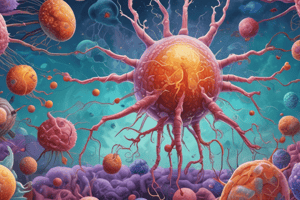Podcast
Questions and Answers
Which gene/defect is associated with Hemochromatosis?
Which gene/defect is associated with Hemochromatosis?
- IX deficiency
- Factor VIII deficiency
- Philadelphia chromosome
- NADPH Oxidase deficiency (correct)
What is the inheritance pattern of Hemochromatosis?
What is the inheritance pattern of Hemochromatosis?
- X-Linked Dominant
- Autosomal Recessive (correct)
- Autosomal Dominant
- X-Linked Recessive
What is the main clinical feature of Hemochromatosis?
What is the main clinical feature of Hemochromatosis?
- Hemorrhage
- Susceptibility to infections
- Failure of phagocytes
- Accumulation of abnormal, pigmented, iron-protein aggregates (correct)
Which population has an incidence of Hemochromatosis at around 0.3%?
Which population has an incidence of Hemochromatosis at around 0.3%?
What leads to the enhanced absorption of dietary iron in Hemochromatosis?
What leads to the enhanced absorption of dietary iron in Hemochromatosis?
What is the gender difference in the susceptibility to Hemochromatosis?
What is the gender difference in the susceptibility to Hemochromatosis?
What is the inheritance pattern of Hemochromatosis?
What is the inheritance pattern of Hemochromatosis?
Which of the following clinical features is associated with Hemochromatosis?
Which of the following clinical features is associated with Hemochromatosis?
What gene/defect is commonly associated with Hemochromatosis?
What gene/defect is commonly associated with Hemochromatosis?
In Hemochromatosis, what is the effect of null mutations in the associated gene?
In Hemochromatosis, what is the effect of null mutations in the associated gene?
Which of the following diseases has maternal transmission and heteroplasty?
Which of the following diseases has maternal transmission and heteroplasty?
What is a common symptom seen in individuals with Hemochromatosis?
What is a common symptom seen in individuals with Hemochromatosis?
Which type of inheritance is associated with Glucose 6-phosphate dehydrogenase deficiency?
Which type of inheritance is associated with Glucose 6-phosphate dehydrogenase deficiency?
What is a common trigger for anemia in individuals with Glucose 6-phosphate dehydrogenase deficiency?
What is a common trigger for anemia in individuals with Glucose 6-phosphate dehydrogenase deficiency?
Which gene is associated with Huntington Disease?
Which gene is associated with Huntington Disease?
What type of genetic condition characterizes Marfan Syndrome?
What type of genetic condition characterizes Marfan Syndrome?
What is a common clinical feature of Cri du Chat Syndrome?
What is a common clinical feature of Cri du Chat Syndrome?
Which type of chromosome abnormality is associated with Cri du Chat Syndrome?
Which type of chromosome abnormality is associated with Cri du Chat Syndrome?
Flashcards are hidden until you start studying
Study Notes
Chronic Myeloid Leukemia
- Characterized by a specific chromosomal abnormality called the Philadelphia (Ph) chromosome, resulting from a translocation between chromosomes 9 and 22
- A somatic mutation, an uncommon type of cancer of the bone marrow
Hemophilia A (Factor VIII Deficiency)
- Caused by a deficiency of Factor VIII
- X-Linked Recessive inheritance pattern
- Clinical features include hemorrhage, hematuria, hemarthroses, and prolonged PTT
Hemophilia B (Factor IX Deficiency)
- Caused by a deficiency of Factor IX
- X-Linked Recessive inheritance pattern
- Clinical features include hemorrhage, hematuria, hemarthroses, and prolonged PTT, which are milder than those of Hemophilia A
Chronic Granulomatous Disease
- Caused by a deficiency of NADPH Oxidase, leading to a lack of peroxides and superoxides, and no oxidative burst in phagocytes
- Inheritance pattern is usually X-Linked
- Clinical features include susceptibility to infections, especially Staph Aureus and Aspergillus spp, with normal B and T cells
Hemochromatosis
- Caused by an unknown gene on the short arm of chromosome 6
- Autosomal recessive inheritance pattern
- Clinical features include enhanced absorption of dietary iron, accumulation of hemosiderin in visceral organs, and symptoms such as cirrhosis, cardiomyopathy, diabetes, skin pigmentation, and arthritis
Hypercholesterolemia
- Caused by a deficiency of the LDL receptor
- Autosomal dominant inheritance pattern, with haploinsufficiency
- Clinical features include impaired uptake of LDL, elevated levels of LDL cholesterol, and increased risk of cardiovascular disease and stroke
Myoclonic Epilepsy (MERRF)
- Caused by a mutation in the tRNAlys gene of mitochondrial DNA
- Maternal transmission and heteroplasty inheritance pattern
- Clinical features include myopathy, dementia, myoclonic seizures, ataxia, and deafness, with age of onset varying depending on the fraction of mutant mitochondrial DNA inherited
Osteogenesis Imperfecta
- Caused by mutations in the genes encoding the α1 or α2 chains of type I collagen
- Autosomal dominant inheritance pattern, with null mutations producing haploinsufficiency and missense mutations producing a dominant negative effect
- Clinical features include deformed, undermineralized bones that are prone to frequent fracture, with neurological symptoms being rare
Glucose 6-Phosphate Dehydrogenase Deficiency
- Caused by a deficiency of glucose 6-phosphate dehydrogenase
- X-Linked recessive inheritance pattern, prominent among individuals of Mediterranean and African descent
- Clinical features include anemia induced by oxidizing drugs, sulfonamide antibiotics, sulfones, and certain foods
Huntington Disease
- Caused by a CAG repeat in the Huntingtin gene (HD)
- Autosomal dominant inheritance pattern, showing anticipation
- Clinical features include progressive motor, cognitive, and psychiatric abnormalities, with chorea being observed in 90% of patients
Marfan Syndrome
- Caused by a mutation in the Fibrillin-1 gene (FBN1)
- Autosomal dominant inheritance pattern, with a dominant negative effect
- Clinical features include abnormalities of the skeleton, heart, pulmonary system, skin, and joints, with a frequent cause of death being congestive heart failure
Cri du Chat Syndrome
- Caused by a deletion of the long arm of chromosome 5 (5p-)
- Autosomal inheritance pattern
- Clinical features include a characteristic "cry of the cat", severe mental retardation, microcephaly, and a cat-like cry
Studying That Suits You
Use AI to generate personalized quizzes and flashcards to suit your learning preferences.



